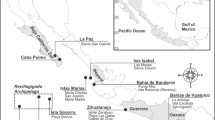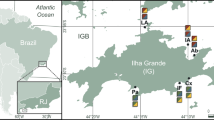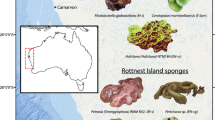Abstract
Sponge faunas from coral reefs and mangrove ecosystems in the Caribbean have mostly been studied from an ecological perspective, with researchers considering the effects of physical and biological factors on their species distribution. To discern evolutionary patterns, this study analyzed the systematic composition, taxonomic diversity, and ecological properties (reproductive strategies, size, shape, endosymbiosis) of mangrove and reef sponge assemblages from seven distant Caribbean localities. Species composition was compared by use of cluster analysis (Sørensen’s), and taxonomic diversity by use of the biodiversity index average taxonomic distinctness (AvTD). Mangrove and reef-associated sponge faunas were found to be statistically dissimilar, with the AvTD values suggesting stronger taxonomic bias toward specific groups in mangroves, irrespective of geographic distance. Most Demospongiae orders have 30–50% more species in coral reefs than in mangroves. The richest reef genera (Agelas, Aplysina, Callyspongia, Petrosia, and Xestospongia) rarely colonize contiguous mangrove formations. The distribution and diversity of suprageneric taxa suggest that coral reef sponge assemblages might represent an older fauna. This historical interpretation would place mangrove subtidal habitats as the youngest marine ecosystem, rather than a below-optimum ecosystem. Life history traits support a biological split discussed here from the perspective of distinct evolutionary histories and different environmental conditions.



Similar content being viewed by others
References
Alcolado, P. M., 2002. Catálogo de las esponjas de Cuba. Avicennia 15: 53–72.
Álvarez, B. & M. C. Díaz, 1985. Las esponjas de un arrecife coralino en el Parque Nacional Archipiélago de Los Roques: Taxonomía y Ecología. Universidad Central de Venezuela, Caracas, Venezuela. Trabajo Especial de Grado para optar al Título de Licenciado en Biología.
Alvizu, A., 2006. Estructura comunitaria de esponjas asociadas a dos parches coralinos en la Isla de Cubagua, Venezuela. Universidad de Oriente, Margarita, Venezuela. Trabajo presentado para optar al título de Licenciado en Biología Marina.
Amaro, M. E., 2005. Demospongiae (Porifera) asociadas a sustrato coralino, en la Bahía de Mochima, Estado Sucre, Venezuela, durante el año 2004–2005. Universidad de Oriente, Cumaná, Venezuela. Trabajo de grado para optar al título de MSc Ciencias Marinas.
Bingham, B. L. & C. M. Young, 1995. Stochastic events and dynamics of mangrove root epifaunal community. Marine Ecology 16: 145–163.
Clarke, K. R., 1993. Non-parametric multivariate analyses of changes in community structure. Australian Journal of Ecology 18: 117–143.
Clarke, K. R. & R. N. Gorley, 2006. Plymouth Routines in Multivariate Ecological Research, Primer V6: User Manual/Tutorial. PRIMER-E Ltd, Plymouth, UK.
Clarke, K. R. & R. M. Warwick, 1998. A taxonomic distinctness index and its statistical properties. Journal of Applied Ecology 35: 523–531.
Clifton, K. E., K. Kim & J. Wulff, 1997. A field guide to the reefs of Caribbean Panamá with emphasis of Western San Blas. In Lessios, H. A. & I. G. Macintyre (eds), Proceedings of the 8th International Coral Reef Symposium, Vol. 1: 167–184.
de Goeij, J. M., H. van den Berg, M. Martine, E. van Oostveen, H. G. Epping & F. C. van Duyl, 2008. Major bulk dissolved organic carbon (DOC) removal by encrusting coral reef cavity sponges. Marine Ecology Progress Series 357: 139–151.
Díaz, M. C., 2005. Common sponges from shallow marine habitats from Bocas del Toro region, Panama. Caribbean Journal of Science 41: 465–475.
Díaz, M. C. & K. Rützler, 2001. Sponge: an essential component of Caribbean coral reefs. Bulletin of Marine Science 69: 535–546.
Díaz, M. C. & K. Rützler, 2009. Biodiversity and abundance of sponges in Caribbean mangrove: indicators of environmental quality. Smithsonian Contributions to the Marine Sciences 38: 151–172.
Diaz, M. C., B. Alvarez & R. A. Laughlin, 1991. The ecology of sponges in a fringing coral reef at the National park “Archipelago de los Roques”, Venezuela II: Community structure. In Rüetzler, K. (ed.), New Perspectives in Sponge Biology. Smithsonian Institution Press, Washington, DC: 367–375.
Díaz, M. C., K. P. Smith & K. Rützler, 2004. Sponge species richness and abundance as indicators of mangrove epibenthic community health. Atoll Research Bulletin 518: 1–17.
Díaz, M. C., R. W. Thacker & K. Rützler, 2007. Haliclona (Soestella) walentinae (Chalinidae, Haplosclerida) and Xestospongia bocatorensis (Petrosiidae, Haplosclerida), two new sponge species from Caribbean Panamá with filamentous cyanobacterial symbionts. In Custódio, M. R., G. Lôbo-Hajdu, E. Hajdu & G. Muricy (eds), Porifera Research: Biodiversity, Innovation, and Sustainability, Vol. 1: 31–36.
Dunlap, M. & J. R. Pawlik, 1996. Video-monitored predation by Caribbean reef fishes on an array of mangrove and reef sponges. Marine Biology 126: 117–123.
Dunlap, M. & J. R. Pawlik, 1998. Spongivory by parrotfish in Florida mangrove and reef habitats. Marine Ecology 19: 325–337.
Duran, S. & K. Rützler, 2006. Ecological speciation in a Caribbean marine sponge. Molecular Phylogenetics and Evolution 40: 292–297.
Ellison, A. M., E. J. Farnsworth & R. E. Merkt, 1999. Origins of mangrove ecosystems and the mangrove biodiversity anomaly. Global Ecology and Biogeography 8: 95–115.
Engel, S. & J. R. Pawlik, 2005a. Interactions among Florida sponges. I. Reef habitats. Marine Ecology Progress Series 303: 133–144.
Engel, S. & J. R. Pawlik, 2005b. Interactions among Florida sponges. II. Mangrove habitats. Marine Ecology Progress Series 303: 145–152.
Farnsworth, E. J. & A. M. Ellison, 1996. Scale-dependent spatial and temporal variability in biogeography of mangrove root epibiont communities. Ecological Monographs 66: 45–66.
Guerra-Castro, E., P. Young, A. Pérez-Vázquez, S. Carteron & A. Alvizu, 2011. Spatial variability and human disturbance of sponge assemblages associated with mangrove roots in the southern Caribbean. Marine & Freshwater Research 62: 491–501.
Hechtel, G. J., 1965. A Systematic Study of the Demospongiae of Port Royal, Jamaica. Peabody Museum of Natural History. Yale University, New Haven, CT.
Hunting, E. R., H. G. van der Geest, A. M. Krieg, M. B. L. van Mierlo & R. W. M. van Soest, 2010. Mangrove–sponge associations: a possible role for tannins. Aquatic Ecology 44: 679–684.
Kobluk, D. R. & R. W. M. van Soest, 1989. Cavity-dwelling sponges in a southern Caribbean coral reef and their paleontological implications. Bulletin of Marine Science 44: 1207–1235.
Lacerda, L. D., J. E. Conde, B. Kjerfve, R. Alvarez-León, C. Alarcón & J. Polanía, 2002. American mangroves. In de Lacerda, L. D. (ed.), Mangrove Ecosystems: Function and Management. Springer-Verlag, Berlin: 1–62.
Lehnert, H. & R. W. M. van Soest, 1996. North Jamaican deep fore-reef sponges. Beaufortia 46: 53–81.
Lehnert, H. & R. W. M. van Soest, 1998. Shallow water sponges of Jamaica. Beaufortia 48: 71–103.
Lesser, M., 2006. Benthic–pelagic coupling on coral reefs: feeding and growth of Caribbean sponges. Journal of Experimental Marine Biology and Ecology 328: 277–288.
Maldonado, M., 2006. The ecology of the sponge larva. Canadian Journal of Zoology 84: 175–194.
Mumby, P. J., A. R. Harborne, J. Williams, C. V. Kappel, D. R. Brumbaugh, F. Micheli, K. E. Holmes, C. P. Dahlgren, C. B. Paris & P. G. Blackwell, 2007. Trophic cascade facilitates coral recruitment in a marine reserve. Proceedings of the National Academy of Sciences USA 104: 8362–8367.
Pauls, S. M., 2003. Esponjas. In Aguillera, M., A. Azócar & E. González (eds), Biodiversidad en Venezuela. Tomo I. Fundación Polar & Ministerio de Ciencia y Tegnología, Caracas: 210–219.
Pawlik, J. R., 1997. Fish predation on Caribbean reef sponges: an emerging perspective of chemical defenses. In Proceedings of the 8th International Coral Reef Symposium, Vol. 2: 1255–1258.
Pawlik, J. R., 1998. Coral reef sponge: do predatory fishes affect their distribution? Limnology and Oceanography 43: 1396–1399.
Pawlik, J. R., S. McMurray & T. P. Henkel, 2007. Abiotic factors control sponge ecology in Florida mangroves. Marine Ecology Progress Series 339: 93–98.
Pérez-Vázquez, A., 2007. Estudio de las comunidades de esponjas sociadas a las raíces del mangle rojo Rhizophora mangle en la Laguna de la Restinga entre julio 2004 y agosto 2005. Universidad de Oriente, Margarita, Venezuela. Trabajo presentado para optar al título de Licenciado en Biología Marina.
Ramirez, I. A., 2010. Taxonomía de esponjas marinas (Porifera) de la Isla de la Tortuga, dependencia federal, Venezuela. Trabajo de grado de Magister en Ciencias Marinas. Universidad de Oriente, Cumana: 114 pp.
Rützler, K., 1995. Low-tide exposure of sponges in a Caribbean mangrove community. Marine Ecology 16: 165–179.
Rützler, K., M. C. Díaz, R. W. M. van Soest, S. Zea, K. P. Smith, B. Álvarez & J. Wulff, 2000. Diversity of sponge fauna in mangrove ponds, Pelican Cays, Belize. Atoll Research Bulletin 476: 230–248.
Sutherland, J. P., 1980. Dynamics of the epibenthic community on roots of the mangrove Rhizophora mangle, at Bahia de Buche, Venezuela. Marine Biology 58: 75–84.
Toffart, J. L., 1983. Les Peuplements des racines de palétuviers en Guadeloupe (Antilles Françaises), I. Analyse floristique et faunistique; méthodologie et premier résultats. Bulletin d’Ecologie 14: 227–239.
van Soest, R. W. M., 1978. Marine sponges from Curaçao and other Caribbean localities. Part I. Keratosa. In Hummelinck, P. W. & L. J. van der Stee (eds), Studies on the Fauna of Curaçao and Other Caribbean Islands, Vol. 56. M. Nijhoff, The Hague: 1–94.
van Soest, R. W. M., 1980. Marine sponges from Curaçao and other Caribbean licalities, Part II. Haplosclerida. In Hummelinck, P. W. & L. J. van der Steen (eds), Studies on the Fauna of Curaçao and Other Caribbean Islands, Vol. 62. M. Nijhoff, The Hague: 1–173.
van Soest, R. W. M., 1984. Marine sponges from Curaçao and other Caribbean localities, Part III. Poecilosclerida. In Hummelinck, P. W. & L. J. van der Steen (eds), Studies on the Fauna of Curacao and Other Caribbean Islands, Vol. 66. M. Nijhoff, The Hague: 1–167.
van Soest, R. W. M., 2009. New sciophilous sponges from the Caribbean (Porifera: Demospongiae). Zootaxa 2107: 1–40.
van Soest, R. W. M., N. Boury-Esnault, J. N. A. Hooper, K. Rützler, N. J. de Voogd, B. Alvarez de Glasby, E. Hajdu, A. B. Pisera, R. Manconi, C. Schoenberg, D. Janussen, K. R. Tabachnick, M. Klautau, B. Picton & M. Kelly, 2010. World Porifera database. http://www.marinespecies.org/porifera.
Wapstra, M. & R. W. M. van Soest, 1987. Sexual reproduction, larval morphology and behaviour in Demosponges from the southwest of the Netherlands. In Vacelet, J. & N. Boury-Esnault (eds), Taxonomy of Porifera. Springer-Verlag, Berlin: 281–307.
Warwick, R. M. & K. R. Clarke, 2001. Practical measures of marine biodiversity based on relatedness of species. Oceanography and Marine Biology: An Annual Review 39: 207–231.
Weil, E., 2006. Diversidad y abundancia relativa de corales, octocorales y esponjas en el Parque Nacional Jaragua, República Dominicana. Revista de Biología Tropical 54: 423–443.
Wood, R., 1998. The ecological evolution of reefs. Annual Reviews of Ecology, Evolution, and Systematics 29: 179–206.
Wulff, J. L., 1997. Parrotfish predation on cryptic sponges of Caribbean coral reefs. Marine Biology 129: 41–52.
Wulff, J., 2004. Sponges on mangrove roots, Twin Cays, Belize: early stages of community assembly. Atoll Research Bulletin 519: 1–10.
Wulff, J. L., 2005. Trade-offs in resistance to competitors and predators, and their effects on the diversity of tropical marine sponges. Journal of Animal Ecology 74: 313–321.
Wulff, J. L., 2009. Sponge community dynamics on Caribbean mangrove roots: significance of species idiosyncrasies. Smithsonian Contributions to Marine Science 38: 501–514.
Acknowledgments
I would like to thank Lic. Paula Young, and Lic. Adriana Perez for their help gathering species distribution data, Dr Pedro Alcolado and Dr Klaus Rützler for providing unpublished species lists, Lic. Edlin Guerra for processing distribution data and performing the similarity and AvTD analyses, Dr Andrzej Pisera, Dr Klaus Rützler, Dr Robert Thacker, and Dr Rob van Soest for their comments, suggestions, and editorial correction of this paper, anonymous reviewers for their valuable comments and corrections, the CCRE-Marine Science Network program, Smithsonian Tropical Research Institute, Bocas del Toro Panama, and NOAA Ocean Exploration Project “Cayman Islands Twilight Zone” for allowing my studies in mangrove and coral reef ecosystems during the last 10 years, the PorTol team and grants for supporting my attendance at the 8th sponge conference, Gerona, Spain, 2010, and the organizers of the conference. Portions of this work were supported by the US National Science Foundation under grant 0829986 to Dr Robert Thacker.
Author information
Authors and Affiliations
Corresponding author
Additional information
Guest editors: M. Maldonado, X. Turon, M. A. Becerro & M. J. Uriz / Ancient animals, new challenges: developments in sponge research
Rights and permissions
About this article
Cite this article
Diaz, M.C. Mangrove and coral reef sponge faunas: untold stories about shallow water Porifera in the Caribbean. Hydrobiologia 687, 179–190 (2012). https://doi.org/10.1007/s10750-011-0952-5
Received:
Accepted:
Published:
Issue Date:
DOI: https://doi.org/10.1007/s10750-011-0952-5




